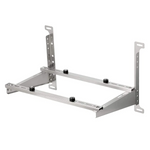What is a dehumidifier and how does a dehumidifier work? If you're reading this, you've probably got these and more questions about dehumidifiers. We'll explain some important concepts first so that you fully understand.
What is indoor relative humidity?
Indoor relative humidity is the amount of water vapor in the air. This can be measured with a hygrometer. Safe levels are between 30% and 55%. Values below and above these levels aren’t healthy for you or for your home. The higher the number, the higher the humidity.

The effects of high indoor relative humidity
The following are some of the effects of high indoor relative humidity:
- Your health can be affected by mold and mildew. These fungi grow easier when there's high humidity. (Read: 3 indoor allergens that love humidity)
- Mold loves materials like wood and drywall, so parts of your home can be in danger.
- An uncomfortable environment: Air feels heavy and it feels harder to move and sometimes breathe.
- Musty smelling clothes: With high humidity, it may be really hard for your clothes to dry off completely. And perhaps, you’ll sweat a lot more. These combined can make them soggy and smelly (read: 9 tips to get mildew smell out of clothes).
- It can damage guitars and music equipment (read: why dehumidifiers make music sound better)
- Mold also loves books and papers. It may fall in love with your favorite book or handwritten letter.

How to lower humidity in house
There are various steps you can take to reduce humidity levels in your space. There seems to be confusion to whether the most effective method is using a humidifier or a dehumidifier. Let see the difference:
Humidifier vs dehumidifier
- Use a humidifier when RH levels are below 30%. It will help you increase humidity levels.
- Use a dehumidifier when RH levels are above 55%. It will help you decrease humidity levels.
How does a dehumidifier work?
Dehumidification is the process of removing water from the air. For refrigerant units, it's a 5 step process.
Refrigerant dehumidifiers
This is a simple 5 step process:
1. Air going inside. An electric fan helps the air circulate. It draws moist air into the unit. The air goes through a grille that's located at one side of the appliance.

2. Filtering. The air first passes through the dehumidifier filter which stops dust and other particles from entering the unit. This helps keep the air clean as it enters and leaves the unit.

3. Cooling. Once filtered, the warm air passes through refrigerated condenser coils. The water vapor begins to cool down as it passes through.
4. Water storage and removal. When it cools down, the water that was in the air turns into water droplets and drips downwards. It passes to the dehumidifier bucket or is drained through a hose. This depends on the drainage mechanism provided by your unit (to learn more read: Pump, or no pump, that's the question).

5. Air going back to the room. At the same time, a heating element reheats the dry air and sends it back into the room through another grille.
The process continues until your desired humidity level is reached.
As easy as that!
Do you have any additional questions? Don't hesitate to contact us at support@tosotdirect.com.
Written in collaboration with Kyle Clark.
|
|
Check out these refrigerant dehumidifier models:
70 Pint TOSOT Dehumidifier with Internal Pump
TOSOT Dehumidifier Features
Click to play video:
TOSOT Dehumidifier Reviews
"Works well, looks good, easy to figure out how to use, and is quieter than the unit it replaced. Haven't tried to use the hose attachment, but that will be my next step." Belvedere
Use information at your own risk: The information presented is intended for educational purposes only and is not intended to be a substitute for professional advice, diagnosis or treatment. Never disregard professional medical or home improvement advice. The information and suggestions should be discussed with a professional. You are responsible for independently verifying the information if you intend to rely upon or use it in any way. You use all the information at your own risk.






